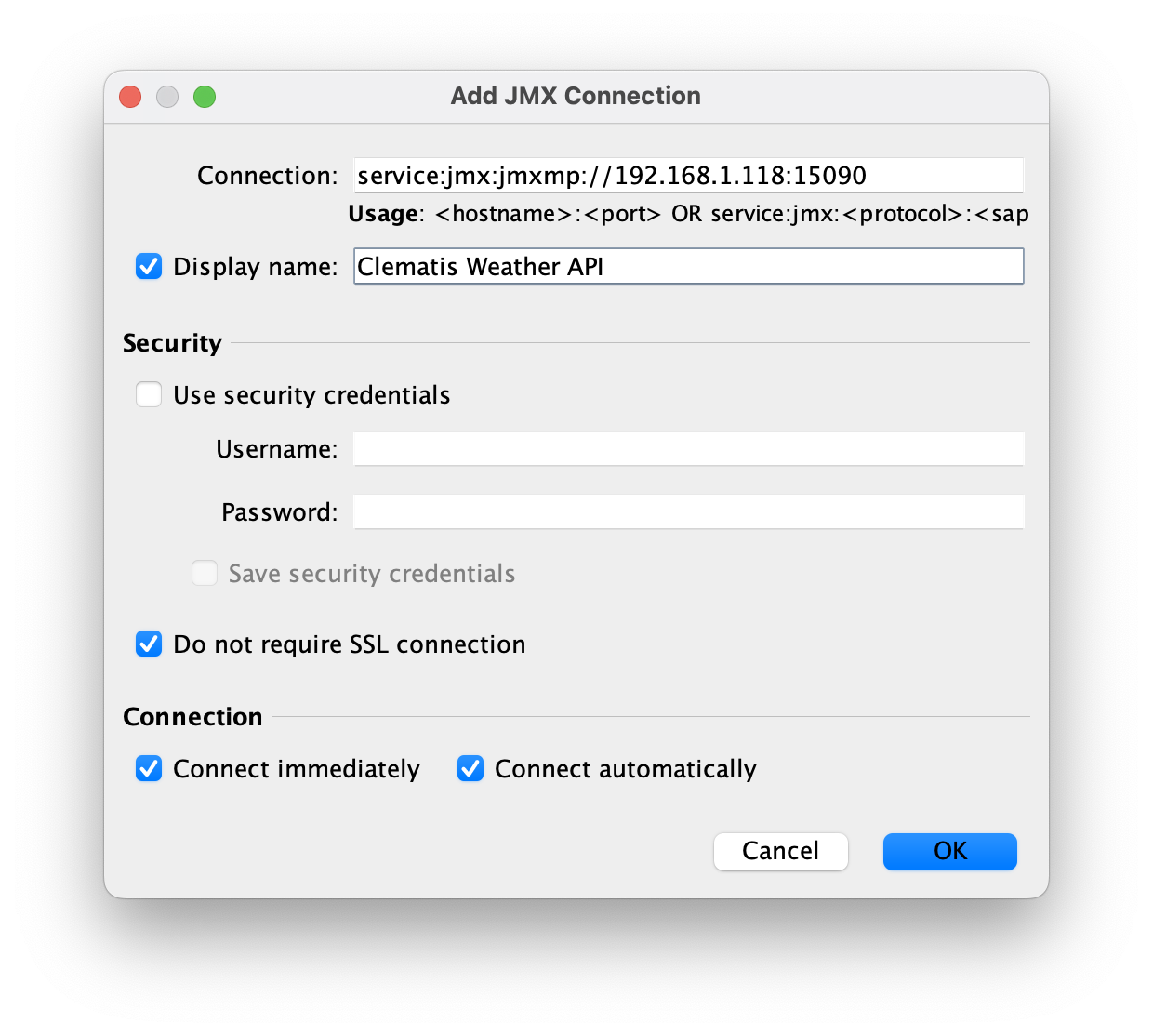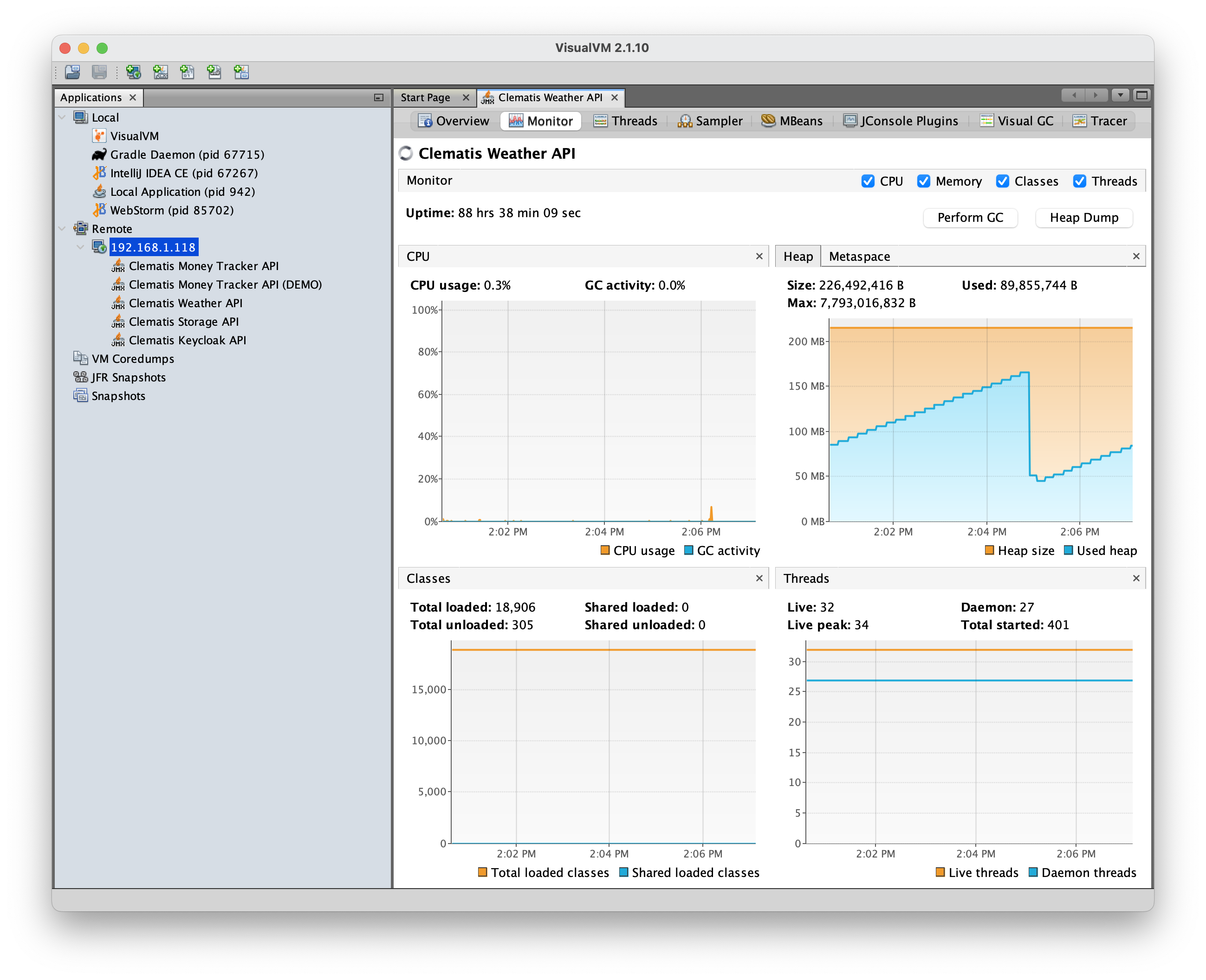Runtime Management
There is a pool of useful diagnostics available for the running Spring applications.
Logback
Logging is being done with the help of Logback library. Spring brings in Logback with
spring-jcl which is set up with a spring-boot-starter-logging starter,
and the latter is in turn a dependency for some other Spring Boot starters, for example spring-boot-starter-web.
Configuration
Clematis applications use logback-spring.xml configuration file to be able to add Spring Boot
Logback Extensions.
The full configuration file is below. It includes configuration for console and file logging, history settings, MDC settings, the ability to change configuration on runtime with JMX and for level of logging:
<configuration>
<springProperty name="LOG_PATH" source="logging.file.path" defaultValue="logs/" />
<jmxConfigurator/>
<conversionRule conversionWord="mdc" converterClass="org.clematis.logging.CustomMDCConverter" />
<appender name="stdout" class="ch.qos.logback.core.ConsoleAppender">
<target>System.out</target>
<filter class="ch.qos.logback.core.filter.EvaluatorFilter">
<evaluator>
<matcher>
<Name>first_retry</Name>
<!-- filter out initial retry messages -->
<regex>Retry: count=0</regex>
</matcher>
<expression>first_retry.matches(formattedMessage)</expression>
</evaluator>
<OnMismatch>NEUTRAL</OnMismatch>
<OnMatch>DENY</OnMatch>
</filter>
<encoder>
<pattern>[%date{"yyyy-MM-dd'T'HH:mm:ss,SSSXXX"}] [%thread] %level %logger{5} - %mdc %msg%n</pattern>
</encoder>
</appender>
<property name="LOG_HISTORY" value="7" />
<property name="LOG_LEVEL" value="INFO" />
<appender name="file" class="ch.qos.logback.core.rolling.RollingFileAppender">
<file>${LOG_PATH}/api.log</file>
<rollingPolicy class="ch.qos.logback.core.rolling.TimeBasedRollingPolicy">
<!-- daily rollover -->
<fileNamePattern>${LOG_PATH}/api.%d.log</fileNamePattern>
<maxHistory>${LOG_HISTORY}</maxHistory>
</rollingPolicy>
<filter class="ch.qos.logback.core.filter.EvaluatorFilter">
<evaluator>
<matcher>
<Name>first_retry</Name>
<!-- filter out initial retry messages -->
<regex>Retry: count=0</regex>
</matcher>
<expression>first_retry.matches(formattedMessage)</expression>
</evaluator>
<OnMismatch>NEUTRAL</OnMismatch>
<OnMatch>DENY</OnMatch>
</filter>
<encoder>
<pattern>[%date{"yyyy-MM-dd'T'HH:mm:ss,SSSXXX"}] [%thread] %level %logger{5} - %mdc %msg%n</pattern>
</encoder>
</appender>
<root level="${LOG_LEVEL}">
<appender-ref ref="file"/>
<appender-ref ref="stdout" />
</root>
<logger name="org.clematis" level="${LOG_LEVEL}"/>
<logger name="jworkspace" level="${LOG_LEVEL}"/>
<logger name="org.springframework" level="${LOG_LEVEL}"/>
</configuration>
The configuration of target directory for logs in the file
above depends on logging.file.path variable from Spring application properties:
logging:
file:
path:
${LOG_PATH}
This variable in turn depends on the presence of environment variable LOG_PATH.
Log Annotations
Lombok helps with logging by providing a number of annotations. The
@Log annotation, which is used accross Clematis applications, is for java.util.logging which can be used with Spring because
jul-to-slf4j bridge is present
if Spring Boot with dependencies management
is on.
It is encouraged to use Lombok @slf4j annotation for classes.
Additional configuration for Java Util Logging is required in Logback, because of the following default behavior:
For an application in a servlet container or application server, logging performed with the Java Util Logging API is not routed into your application’s logs. This prevents logging performed by the container or other applications that have been deployed to it from appearing in your application’s logs.
Slf4J, Log4J, Logback are the projects with QOS.ch Sarl as a founding contributor.
Mapped Diagnostic Context (MDC)
As it is noted in the previous paragraph, it's preferable to use @slf4j logging. This is
mainly because MDC feature relies on it. For
java.util.logging the information will need to be retrieved by a user code.
Transaction Identifiers
Clematis applications need only a small portion of information to be shared in MDC, and a transaction identifier is the most important case:
- org.clematis.logging.web.TransactionIdFilter: intercepts client queries and checks for presence of transaction identifiers in HTTP headers. If no identifier is found, a new one is created and added to an MDC context:
@Component(value = "transactionIdFilter")
public class TransactionIdFilter extends OncePerRequestFilter {
@Value("${clematis.transactionId.httpHeader}")
private String transactionIdHeader;
@Autowired
private TransactionIdService transactionIdService;
@Override
protected void doFilterInternal(HttpServletRequest request, HttpServletResponse response, FilterChain filterChain)
throws IOException, ServletException {
final String transactionId = request.getHeader(transactionIdHeader);
try (
TransactionIdService.Transaction transaction = transactionIdService.startTransaction(transactionId)) {
response.addHeader(transactionIdHeader,
URLEncoder.encode(transaction.id(), StandardCharsets.UTF_8.displayName()));
filterChain.doFilter(request, response);
}
}
}
- org.clematis.logging.service.TransactionIdService: generates a new transaction id, uses MDC to store the id and deletes it after id is no longer used. This is being done for every running request thread in the Spring application:
@Component(value = TransactionIdService.BEAN)
public class TransactionIdServiceImpl implements TransactionIdService {
@Value("${clematis.transactionId.logKey}")
private String transactionIdLogKey;
@Override
public Transaction startTransaction(@Nullable String id) {
final String transactionId = StringUtils.isBlank(id) ? generateId() : id;
return new TransactionImpl(transactionIdLogKey, transactionId);
}
@Override
public String getCurrentTransactionId() {
return MDC.get(transactionIdLogKey);
}
private static String generateId() {
return UUID.randomUUID().toString();
}
private record TransactionImpl(String mdcKey, String id) implements Transaction {
private TransactionImpl(String mdcKey, String id) {
this.mdcKey = mdcKey;
this.id = id;
MDC.put(mdcKey, id);
}
@Override
public void close() {
MDC.remove(mdcKey);
}
@Override
public String toString() {
return "TransactionImpl{id='" + id + "'}";
}
}
}
- org.clematis.logging.CustomMDCConverter: is used with Logback configuration to format MDC information and to actually insert a transaction identifier into logs:
<configuration>
<conversionRule conversionWord="mdc" converterClass="org.clematis.logging.CustomMDCConverter" />
<encoder>
<pattern>[%date{"yyyy-MM-dd'T'HH:mm:ss,SSSXXX"}] [%thread] %level %logger{5} - %mdc %msg%n</pattern>
</encoder>
</configuration>
These classes will soon be available as a shared library.
Runtime Diagnostic With JMX
Clematis applications use Spring JMX to create, start, and expose a JSR-160 connector:
import org.springframework.beans.factory.annotation.Value;
import org.springframework.context.annotation.Bean;
import org.springframework.context.annotation.Configuration;
import org.springframework.jmx.support.ConnectorServerFactoryBean;
/**
* JMXMP configuration
*/
@Configuration
public class ConnectorServiceFactoryBeanProvider {
@Value("${spring.jmx.url}")
private String url;
@Bean
public ConnectorServerFactoryBean connectorServerFactoryBean() {
final ConnectorServerFactoryBean connectorServerFactoryBean = new ConnectorServerFactoryBean();
connectorServerFactoryBean.setServiceUrl(url);
return connectorServerFactoryBean;
}
}
The spring.jmx.url is a variable from Spring application properties, in turn
it depends on environment variables JMXMP_HOST and JMXMP_PORT:
spring:
jmx:
enabled: true
url: service:jmx:jmxmp://${JMXMP_HOST}:${JMXMP_PORT}/
management:
endpoints:
jmx:
exposure:
include: "health,info,env,beans"
web:
exposure:
include: "health,info,env,beans"
The management section provides configuration for beans exposure over JMX or HTTP protocols.
Clematis JMXMP Connectors are being used without optional SSL and SASL, however, it can be turned on in no time if used outside the sandbox.
Configure VisualVM for JMXMP
VisualVM doesn't work with JMXMP protocol out of the box; however, it can be added to it.
- Download
jmxremote_optional-repackaged-5.0.jarfrom Maven:
curl --output jmxremote_optional-repackaged-5.0.jar "https://repo1.maven.org/maven2/org/glassfish/main/external/jmxremote_optional-repackaged/5.0/jmxremote_optional-repackaged-5.0.jar"
- Install VisualVM for your platform
- Add
jmxremote_optional-repackaged-5.0.jarto VisualVM classpath, for example, for macOS:
mv jmxremote_optional-repackaged-5.0.jar /Applications/VisualVM.app/Contents/Resources/visualvm/platform/lib/
- Run VisualVM and create a JMXMP connection leaving fields for credentials blank and do not require SSL connection this time:

- Click OK and the connection should be established:
